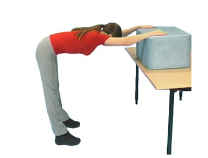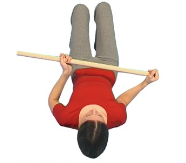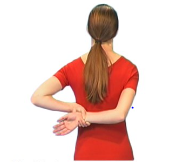Frozen Shoulder
What you should know
The shoulder joint is a ball and socket joint which is surrounded by a structure called the joint capsule. The joint capsule is usually very mobile and flexible, moving freely as you move your arm.
A frozen shoulder happens when inflammation of the joint capsule causes pain and stiffness in the shoulder joint. Pain is felt in the upper arm but can sometimes radiate into the whole arm.
Frozen shoulder is also described as adhesive capsulitis, a stiff shoulder or a contracted shoulder. Generally frozen shoulder comes on over a period of time, or in some cases can occur after an injury.
The good news is that in most cases it isn’t a serious problem will usually get better over time. As far as possible, it’s best to continue with your normal everyday activities as soon as you can and to keep moving.
Frozen shoulder is more common in women, people who are aged 40-60 years and people with diabetes.
What to do
There are many ways in which you can help reduce the pain associated with a frozen shoulder. Although they may not remove the pain completely they should reduce it.
Keep moving
Staying generally active is the most important way you can help yourself if you have frozen shoulder. It releases chemicals called endorphins, which are the body’s natural painkillers. These improve pain and make you feel happier.
General exercise might make your shoulder feel a bit sore at first but it doesn’t cause any harm – so don’t let it put you off. It’s important that you continue to exercise regularly and don’t stop when the pain is gone and you’re feeling better, for your long-term general health.
The main principle of treatment for frozen shoulder is specific exercises to help stretch out the shoulder in all directions (see below).
Pain medication
It may surprise you, but simple over the counter painkillers such as paracetamol and ibuprofen are the most effective pain medication. If you feel you need them – use them, following advice of a pharmacist. You should only take the recommended daily dose but do not wait until your pain is out of control to take them.
Consult with your GP or Pharmacist if you have any concerns and do not take ibuprofen or aspirin if you are pregnant or have asthma, an ulcer or indigestion.
Heat
Heat is effective in reducing the pain associated with a frozen shoulder. Use heat for 10-15 minutes, this could be a hot water bottle, warm bath or shower or heat pad.
You should make sure there is something between your skin and the source of heat such as a paper towel or tea-towel.
Sleep
Sleep is really important when it comes to managing pain. Studies suggest that getting a good night sleep can reduce pain levels by as much as 25%.
Tips to improve your sleep include:
- Sleeping in a dark, quiet and cool room
- Support your shoulder or arm with a pillow if needed
- Try taking pain relief an hour before you go to bed
- Do not consume caffeine within six hours of sleeping
- Try to avoid eating within two hours of sleeping
- Try not to be in front of bright screens such as TVs, laptops or phones for one hour before bed
- Keep your bedroom as a place to sleep - do not use it for work or as an office
- If you do wake in the night and cannot get back to sleep - get up, go to another room and do something until you are tired enough to sleep
Diet and nutrition
There are no special diets that have been shown to either help or prevent frozen shoulder.
What’s recommend for us all is a well-balanced and healthy diet, which is low in saturated fats, sugar and salt. It’s also a very good idea to eat plenty of fresh fruit and vegetables, and to drink plenty of water.
If you need to lose weight, the key is to regularly burn off more energy than you consume on a daily basis.
Exercises
If an exercise is painful to undertake or causes a moderate to high level of pain during or afterwards then reduce the difficulty level or stop that specific exercise.
- Walkaway: Stand with your legs hip width apart and lean your upper trunk forward, rest your hands on a surface. Gently let the upper trunk drop down until you can feel stretching in your sides and chest muscles. Keep arms straight and stretch for approx. 5 seconds and repeat 10 times.

.png)
- External rotation at the side: Lie on your back with elbows against your body and at a right angle. Hold a stick in your hands. Move the stick sideways thus pushing the arm to be exercised outwards. Repeat 10 times.

.png)
- Hand behind your back: Stand with arms behind your back. Grasp the wrist of the arm you want to exercise. Slide your hands up the back. Repeat 10 times.

.png)
When to see your GP or Physiotherapist
- If you have had an accident or trauma to the shoulder
- If you have any redness or swelling of the shoulder
- If you feel unwell or have a fever
- If you have developed a new cough or have breathlessness as well as shoulder pain
- If you have a history of cancer, osteoporosis, steroid use, or excessive drug or alcohol use
- If there is no improvement with these exercises after a month
Further resources
- NHS website: frozen shoulder
- Versus Arthritis: shoulder pain information
- Versus Arthritis: shoulder pain exercises
- NHS - Sleep problems
- NHS - Lose weight (includes the NHS app for weight loss)
- NHS - Quit smoking (includes the NHS quit smoking app)
Authors: Catrin Maddocks, Jemima Cope, Jane Leah and Cianán O’Sullivan
Review Date: February 2025